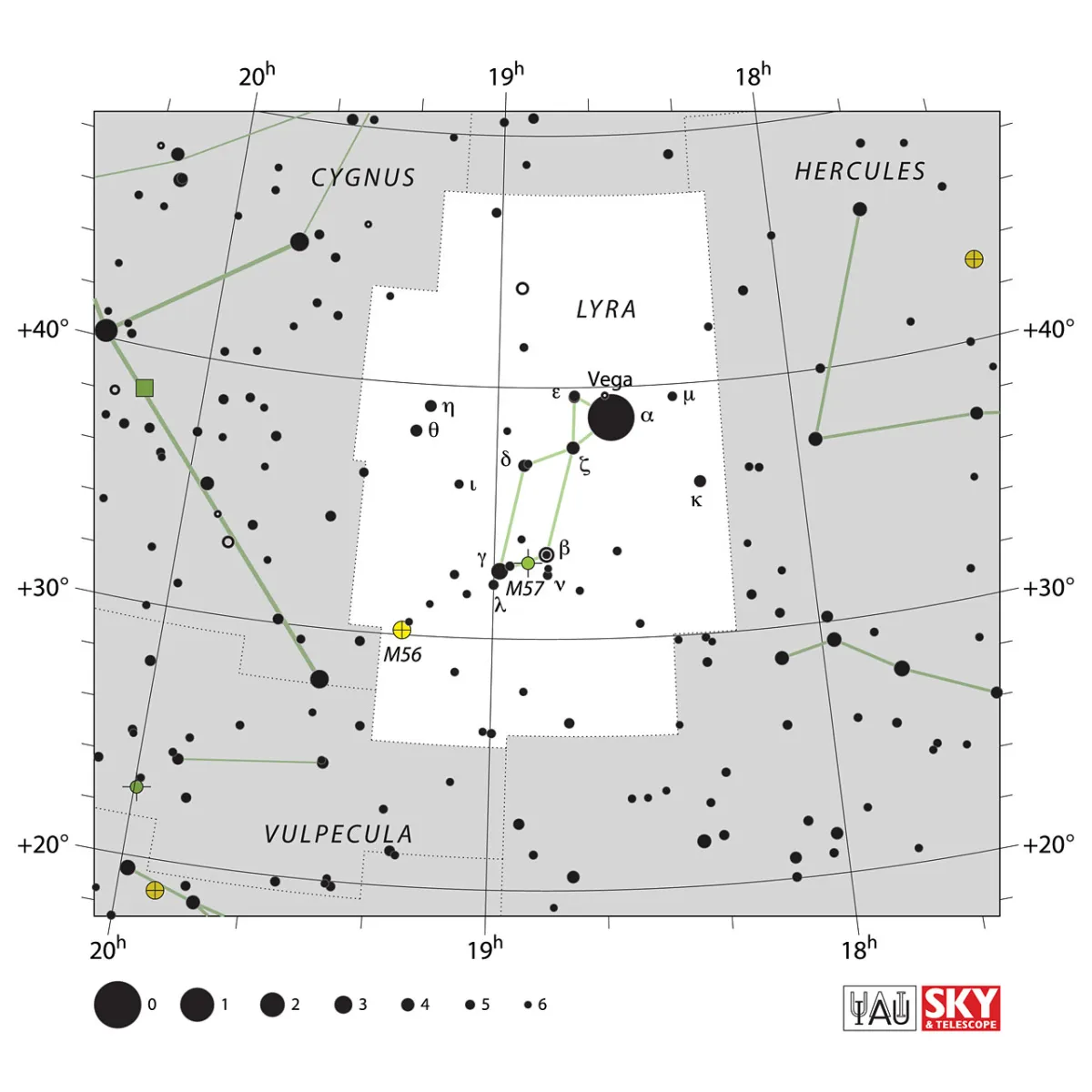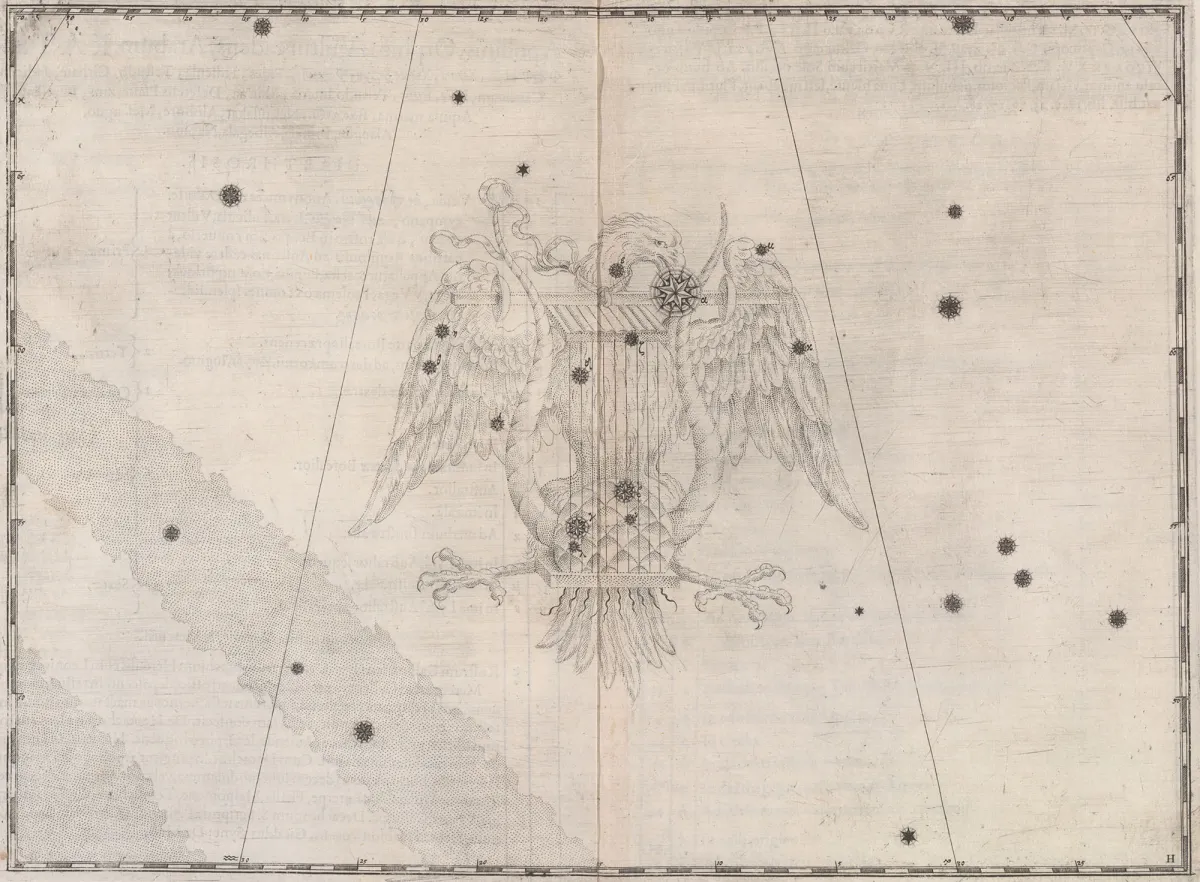Constellation Lyra (Lyre)

Properties
The constellation lies between Cygnus and Hercules. Lyra is a small, but striking and memorable constellation with an area of 286 square degrees, as it has the fifth brightest star Wega, which forms the summer triangle together with Atair (α Aquilae) and Deneb (α Cygni). Southeast of Wega is a striking parallelogram made up of four stars. To the north is the four-fold star ε1 / ε2 Lyrae, whose two double components, separated by 208 ", can be separated with the naked eye on a clear, calm night and thus serve as a good test for visual acuity. In the telescope, the two double stars turn out to be double stars again , which results in a four-fold star system The centre of the constellation culminates around midnight on July 2nd. [9, 15]
| α Lyr | Vega, Wega, Fidis, Harp Star |
| β Lyr | Sheliak, Shelyak, Shiliak |
| γ Lyr | Sulafat, Sulaphat |
| η Lyr | Aladfar |
| μ Lyr | Alathfar, Al Athfar |
| IAU Name | Lyra |
| IAU Genitive | Lyrae |
| IAU Abbr. | Lyr |
| English Name | Lyre |
| Culmination at local midnight | 4 July |
| Season (Latitude +0.0°) | March … December |
| Right Ascension (J2000.0) | 18h 13m 52s … 19h 28m 29s |
| Declination (J2000.0) | +25° 39' 51" … +47° 42' 52" |
| Area | 286 deg2 |
| Neighbours (N↻) | Dra, Her, Vul, Cyg |
Deep-Sky Object Descriptions
Catalogues
Mythology and History
In Greek mythology, Hermes was the son of Zeus. He wore a winged hat and wing shoes. He was the protector of traders and thieves and the master in every art of deception. It was he who invented the lyre. When he was still a child he saw a turtle grazing in the grass. He carried her home, grazed her, took her shell, pulled a cowhide over it, stretched seven strings of sheep intestine over a bridge and let it sound.
This lyre later came into the possession of Apollon, who finally passed it on to his son Orpheus, who was a mighty singer and wanted to woo Eurydice. Hymenaeus, the god of marriage, came to marry them, but bad omens made the future seem dark. When the newlywed Eurydice was walking in the garden, she was bitten by a snake, collapsed and died.

Orpheus descended into the underworld, playing on his lyre and singing along with it. He wanted to bring his wife back to life. He penetrated through the multitudes of airy structures and the shapes beyond the grave to Hades, the ruler of the underworld. Orpheus sang of the injustice of his wife's death and asked for her release. While he was singing to the sound of his strings, the bloodless souls began to weep, Tantalus no longer snapped for escaping water, Ixion's wheel stood still, the vultures no longer chopped on Tityo's liver, the Danaids carried no jugs and Sisyphus rested on his boulder . At that time, so the legend goes, tears wet the cheeks of the furies for the first time because the song touched them. Neither Hades' wife, Persephone, nor himself could refuse the supplicant's request. They called Eurydice. She stayed with the recently arrived shadows and walked slowly along because of the wound. Orpheus took her by the hand and was instructed not to turn his eyes until he had left the valley of the dead, otherwise the gift would be revoked.
Orpheus and Eurydice silently climbed the steep path to the upper world, for it was difficult to find in the thick, pitch-black darkness. Already they were not far from the border of the upper world, but Orpheus could no longer hear his wife's footsteps. Then he turned around, afraid that it might already be gone. But there stood Eurydice, more beautiful than before. As she disappeared, she stretched out her arms, longing to embrace Orpheus and to be embraced, but the unfortunate woman only reaches into the escaping air. When she died for the second time, she did not let a word of complaint about her husband be heard - what else could she complain about but his love for her? She breathed one last farewell, barely audible to his ears, and sank back to where she had come from. [20, 69]
According to another legend, the lyre was owned by the Greek poet Arion from Lesbos around 600 BC. He also knew how to play his instrument in an inimitable way.
According to the story, the constellation Lyra, Lyra, Cithara (four-stringed zither), Orphei, Orphica, Mercurialis, Mercurii is named. The names Marina (emerged from the sea), Testudo (lid animal, turtle) and Belua aqatica (water animal) are reminiscent of Hermes' (Mercury's) handicraft work, in which he covered a turtle shell with cowhide and stretched gut strings over it. [20] The constellation has also been interpreted as an eagle or vulture. [7, 20]